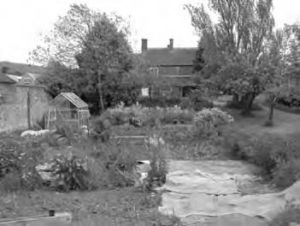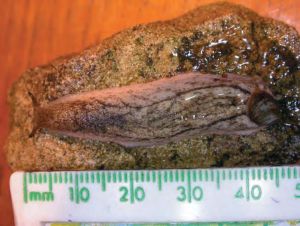|
On 7 April 2005 Juliet Bailey, an active member of the Gloucestershire Naturalists’ Society and the Gloucestershire Wildlife Trust found and photographed a slug in her farm garden at Standish, SO 80-09- which I was able later to examine. It turned out to be Testacella maugei, last noted in Conchological Society records in Gloucestershire in 1916, at St Paul’s Road Gloucester and in Watsonian vice-county 33 (information from Geraldine Holyoak). Amplification of the 1916 record comes from Charles Upton: “I have found it fairly abundant in the garden of nr 26 St Paul’s Road, Gloucester. This is in Gloucester East,” (“Additional Notes on the Land and Fresh-water Mollusca of Gloucestershire” Proceedings of the Cotteswold Naturalists’ Field Club 19(3) 1917:229-232). In the hope that readers will turn it up elsewhere not just in Gloucestershire, here is Juliet’s account of the find. “The slug was found in a vegetable garden run on organic principles. It was under an old carpet that was being used as a light excluding mulch to kill off a vigorous cover of weeds. The carpet had been in place for about six months over the winter and was lifted to prepare the ground for potatoes. The site is in a hamlet about 10 km from Gloucester beside a busy B-road. There is evidence that the site has been in regular use since about 1750. There are abundant sherds of pottery dating from this period, as well as clay pipe fragments, continuing through until the early 20th century (when rubbish collection may have started). (Thanks to Dr Alan Vince for examining the pottery.) It is about 50 metres west of a farmhouse and dairy that was the centre of a substantial cheese making enterprise. Early maps of the site dating from 1811 and the 1830s show not only the farmhouse but a pair of labourers’ cottages 20 metres to the west. Its use in the 20th century is not so clear, though it is the obvious place to site a vegetable garden associated with the farmhouse. Locals say that some 20 years ago it was a productive garden, though little worked in recent years until the present owner arrived in 2001. One can envisage the garden having been used for vegetables throughout most of the 19th and 20th centuries, regularly disturbed and fertilized with domestic waste, and possibly also cattle manure.” The only recent Testacella record I am aware of from anywhere near here is Testacella scutulum found by David Scott- Langley at Combe,Oxfordshire SP 412153, 30 November 2001. So congratulations to Juliet. |
Fig 1.
Fig 2. Testacella maugei
|
An Elusive Slug Testacella maugei
Issue
8
Page
8
Species


